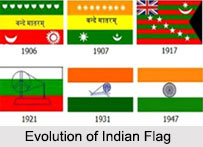 Evolution of the Indian National Flag sailed through many transformations to arrive at what it is today. These changes reflect the political developments of the country. Since the Independence of India till date, brave soldiers of the Indian Armed Forces has saved the Indian National Flag from enemies and maintained its full glory.
Evolution of the Indian National Flag sailed through many transformations to arrive at what it is today. These changes reflect the political developments of the country. Since the Independence of India till date, brave soldiers of the Indian Armed Forces has saved the Indian National Flag from enemies and maintained its full glory.
Indian National Flag is a symbol of national pride which represents hopes and aspirations of Indian people. The history of the Indian Flag dates back to pre-independence era. It was between 1904 and 1906 that the first Indian Flag came into existence.
History of Flag in Indian Army
The word "Dhvaj" (Flag) occurs in the Rig Veda. The Indo-Aryans carried them into the battle for their utility as rallying points and as markers for deployment before battle. In a volunteer force, soldiers needed to identify with sub-groups whose fortunes and honour they could share. In due course, flags became an insignia of royalty as the King represented the State.
Significance of Flag in Indian Army
The ancient armies of Indian King had their own multitude of flag and banners to embolden and spur the soldiers to attain greater glory. Individual warriors acquired their own distinctive flags with a special identification device. Flags were displayed on a staff fixed to the rear board of the chariot and it was the duty of the warrior to defend his own flag as a symbol of his honour. Each elephant carried a flag. The purpose of this display was to make the army look impressive and adversely affect the enemy"s morale.
In South India, each Tamil king had a personal flag with a distinctive device emblazoned on it. The personal standard of Chera, Chola and Pandya rulers depicted a fish, a bow and a tiger respectively. White flags denoted victory and were displayed by an army to announce victory in the battle.
Evolution of Indian Flag
Prior to the Sepoy Mutiny in 1857, the fragmented nation of India was represented by the individual flags of the various princely states. Post the Sepoy Mutiny, the British established Imperial rule in India and a flag was introduced to represent the British colony of India.
The first unofficial flag to be hoisted by the Indians happened on August 7, 1906 in Calcutta. The rectangular flag consisted of three horizontal stripes of green, yellow and red from top to bottom. The uppermost green segment contained 8 lotuses representing 8 provinces, the middle yellow segment bore the words "Bande Mataram" in Sanskrit and the bottom red band had a crescent on the left and a sun on the right hand side.
A slightly modified version of the previous flag was hoisted in 1907 by Madame Bhikaji Cama and her group of exiled revolutionaries in Paris. The uppermost strip had 7 lotuses instead of 8 and it was the first time the colour saffron was used in the flag.
In 1921, Mahatma Gandhi proposed a tri-coloured flag with the symbol of the spinning wheel at its center. The colours of the flag represented the dominant religions of the Indian subcontinent with clear message of promoting religious harmony.
Another version of the flag closest to the current one came into existence on April 13, 1923 which was hoisted in Nagpur during an event commemorating the Jalianwalabagh Massacre. It was named the "Swaraj Flag" and became the symbol of India"s demand for Self-rule led by the Indian National Congress. On July 22, 1947, the Constituent Assembly of India adopted the Swaraj Flag as the National Flag of Sovereign India with the Ashok Chakra replacing the spinning wheel.




















